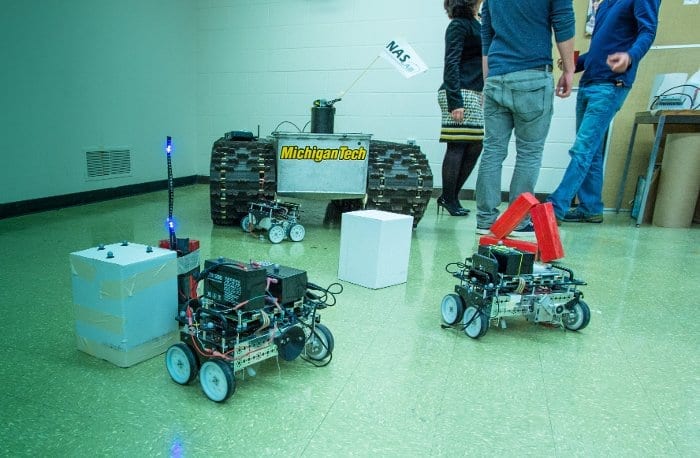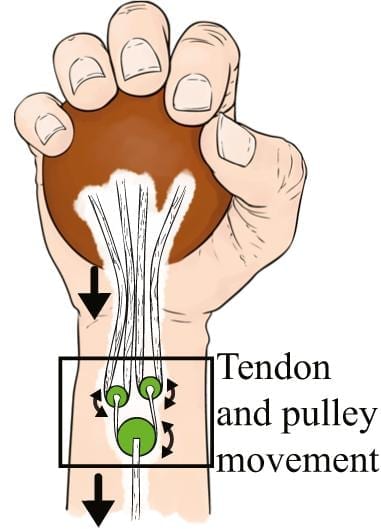
Little robots in Nina Mahmoudian’s lab bring power to turn on a light, front left, and wave the white flag on the mini-tank. Adapted to real-world conditions, such robots could restore power to critical infrastructure, like cell towers.
Big disasters almost always result in big power failures. Not only do they take down the TV and fridge, they also wreak havoc with key infrastructure like cell towers. That can delay search and rescue operations at a time when minutes count.
Now, a team led by Nina Mahmoudian of Michigan Technological University has developed a tabletop model of a robot team that can bring power to places that need it the most.
“If we can regain power in communication towers, then we can find the people we need to rescue,” says Mahmoudian, an assistant professor of mechanical engineering–engineering mechanics. “And the human rescuers can communicate with each other.”
Unfortunately, cell towers are often located in hard-to-reach places, she says. “If we could deploy robots there, that would be the first step toward recovery.”
The team has programmed robots to restore power in small electrical networks, linking up power cords and batteries to light a little lamp or set a flag to waving with a small electrical motor. The robots operate independently, choosing the shortest path and avoiding obstacles, just as you would want them to if they were hooking up an emergency power source to a cell tower. To view the robots in action, see the video posted on Mahmoudian’s website.
“Our robots can carry batteries, or possibly a photovoltaic system or a generator,” Mahmoudian said. The team is also working with Wayne Weaver, the Dave House Associate Professor of Electrical Engineering, to incorporate a power converter, since different systems and countries have different electrical requirements (as anyone who has ever blown out a hair dryer in Spain can attest).
The Latest on: Robot repair team
[google_news title=”” keyword=”Robot repair team” num_posts=”10″ blurb_length=”0″ show_thumb=”left”]
via Google News
The Latest on: Robot repair team
- Longmont High robotics team wins top award at VEX World championshipon April 29, 2024 at 8:30 pm
The four members of the Longmont High “Pronounce This” robotics team won the top award at the recent high school VEX World championship, giving them the distinction of the best all around team out ...
- Saratoga High School robotics team advances to world championshipson April 28, 2024 at 1:08 pm
The Saratoga High School VEX Robotics Team 95071X advanced to the 2024 VEX robotics championship in Dallas April 25-27 after setting records at a regional competition held earlier that month.
- Coloma High School Robotics Team Sees Success in First Worlds Championshipon April 28, 2024 at 6:01 am
The Coloma High School Robotics team has returned home after a successful first trip to Houston, Texas for their first ever worlds championship competition. The team placed 16th out of their field of ...
- Shape-shifting robot escapes jail: A leap in adaptive technologyon April 26, 2024 at 7:13 am
The robot changes its shape and escapes from a tiny metal-bar cell. While this may sound like a plot from a science fiction movie, a team of scientists has turned this idea into reality. They've ...
- Middle School robotics team plans flea market fundraiseron April 25, 2024 at 6:45 pm
The Charles City Cosmic Snowballs are planning a flea market fundraiser to support the team’s upcoming trip to Florida for a FIRST LEGO League competition.
- UT robotics team designs robot to protect firefighters for national competitionon April 24, 2024 at 8:22 am
The Paradigm Robotics team, from the University of Texas, has created the Firebot, a robot designed to protect firefighters as they battle fires.
- Philadelphia's Central High School robotics team wins world championshipon April 24, 2024 at 7:39 am
Central High School's "RoboLancers" won this year's "FIRST Robotics Competition" in Houston. Six hundred teams from around the world qualified for the four-day event. After qualification rounds, ...
- Cary middle school robotics team qualifies for world championshipon April 23, 2024 at 4:23 pm
A middle school robotics team from Wake County has qualified to compete with top teams from around the world. The RoboRisers, a team of seventh graders from Mills Park Middle School in Cary, are ...
- Arres Prevent robot uses advanced AI to fight potholes [video]on April 23, 2024 at 7:48 am
A UK-based startup called Robotiz3d claims it's invented a world's first: an autonomous electric vehicle that can fix and prevent potholes.
- AI-powered robots can now autonomously repair other botson April 17, 2024 at 9:05 am
Back in January, researchers showed off the kitchen skills of an open-source Aloha housekeeping robot. Now the Unleashed project gets to grips with knotting shoelaces, hanging shirts and even ...
via Bing News









